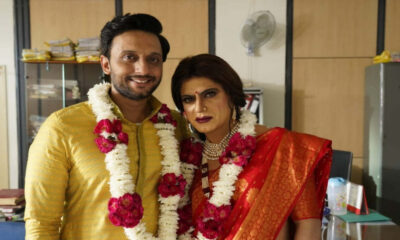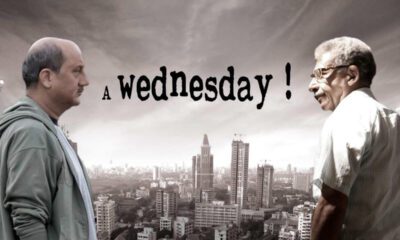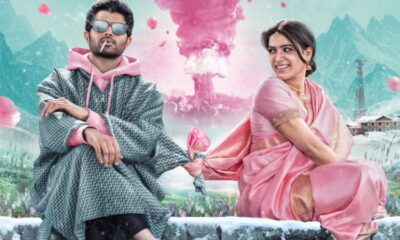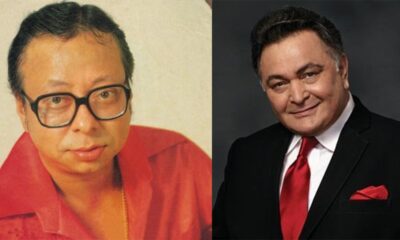Bollywood News
Subhash K Jha’s Lockdown Blueschasers Continued

Fashion(2008): The sum-total of Bhandarkar’s vision is far greater than the captivating
components that characterize his protagonist’s journey to painful self realization.
If we go right down to the basic issue of morality in Bhandarkar’s cinema then all his protagonists reach a stage in their life when they cannot look themselves straight in the eye.
That moment of ‘wreckon-in’ in Fashion is steeped in a windswept dereliction that reflects itself effortless in Priyanka Chopra’s face.
Yup, this is her moment of glorious reckoning . It’s her character Meghna’s journey from the innocent aridity of Chandigarh to the fruitful corruption of Mumbai’s modeling world that defines the resplendent rhythms of Bhandarkar’s cinema.
This remarkably resonant film is arguably Bhandarkar’s most accomplished work to date, though Page 3 comes close in terms of etching out even the smallest of characters with a deft sensitivity that connects them to a world far beyond the one his camera captures on screen.
Mahesh Limaye’s cinematography is a little predictable in its bustle-and-bristle images. Couldn’t the visuals have avoided the ‘clutter’ clichés on urbal lifestyles? Fortunately the storytelling is anything but predictable.
Screenwriting has always been the greatest strength of Bhandarkar’s cinema. Fashion is exceptionally skilled in its writing. The screenplay(Bhandarkar, Anuradha Tiwari and Ajay Monga) conveys a lived-in ‘overheard-at-a-party’ kind of conversational tone where every sentence seems the opposite of bombastic.
Rhetorics and high-drama are exchanged for fearless transparency in the characterizations and conversations, so that what we eventually look at is not a tantalizing dekko at the beau monde but a breathtaking map of a heartbroken humanity who occupy the upper crust of the urban social order and eventually have to slow down on their fast tracks to wonder, ‘Is this really worth it?”
By the the time ramp queen Meghna Mathur reaches this self-searching stage , Fashion becomes not a macro-cosmic view of the ramp walk , talk and shock, but a story of two women , one who already ‘has-been’ there(Kangana Ranaut) and the other who just about saves herself from catastrophe in the nick of time.
Indeed the sequences between Priyanka and Kangana are the goosebumpy highlights of this bumpy beguiling journey into heartbreak and desolation. In a sequence such as the pre-interval one where the ousted ramp queen Kangana confronts and warns the new ramp rani Priyanka in a restaurant loo , or later after they bond(oh so beautifully that you feel a lingering lump in your throat) when Kangana urges her new soul-mate to grab a second chance, the screen splits wide open to reveal the dark fissures that are hidden just beneath the seamless splendour of the glamour industry.
Whether it’s sexual or emotional , Bhandarkar has never flinched from telling it like it is. Fashion shocks us with its brutal forthrightness on matters of the heart and pants.
Samir Soni performs a very complex tight-rope as a closet-gay designer who balances a lover with his mother’s demand for a wife with a marriage of convenience with a stunning model friend played Mugdha Godse.
Mugdha is the female discovery of the year. With a figure that could launch thousands of cola sips and face that registers a spectrum of emotions she gives a compelling consistently to her goodhearted model’s character .She neatly offsets and balances Kangana familiar-yet-compelling traumatic act, done here at a gut-wrenching decibel.
What Kangana does in Fashion, no other actress can do. But there’re no surprises in her performance.She has done it. We’ve seen it before.
Priyanka catches you completely unaware. Her transformation from the khati-peeti girl from Chandigarh to the super-ambitious super-model who dumps boyfriend and conscience to pursue her dreams, is achieved with a gentle subtlety and bridled passion . This is Priyanka’s coming-of-age film. She looks like a zillion bucks. And acts like a woman who connects with the darkest most desperate human emotions without wallowing in them.
Every character is written to accentuate the specific actor’s grace in the given space. Even by the overall high-octane caliber of performances Kitu Gidwani and Ashwin Mushran stand out. Harsh Chaya’s ‘gay lisp’(?) was the only annoying appendage in the otherwise-immaculate casting .
Also, the ramp walks could have been done with slightly more élan and subtlety. Yeah we see the best models strutting and pouting as the flashes go berserk.
But what else?
Eventually the evocative screenplay decides to give its fallen heroine a second chance. But that seems like more like cinematic liberty than an effort to define the straight-from-the-hip quality that we encounter in most of the journey from dimmed lights to damned souls…Madhur Bhandarkar takes us through a labyrinth of emotions, some devastating in their gut-level directness. But at the end we come away with a film that gives us something to hold on to permanently even as the characters on screen lose practically everything worth holding on to.
A truly outstanding film and one that brightens your Diwali in ways that don’t show up on the surface.
Dasvidaniya(2008): Returning to the ambit of the dull workingclass protagonist that he almost patented in Bheja Fry Vinay Pathak delivers yet another bravura performance as a man who learns to live only when he learns he has to die.
The premise done to death(pun intended) in films as disparate as Akira Kurosawa’s Ikuru and Hrishikesh Mukherjee’s Anand, gets its power and glory from the simple yet never simplistic narrative that grows on you…piece by piece….just as the lessons of life creep up belatedly on our hero Amar Kaul.
With every dying day he lives a little more of that life he leaves behind . Though the film’s leisurely pace doesn’t quite capture the urgency of the moment, Dusvidaniya scores high point for its sincerity of performance reflected in every performance. The narrative has been patterned prettily as a pastiche of ten episodes each dealing with a facet of Amar Kaul’s life that he would like to retrieve from the archives of angst and claim as his own before he’s gone.
The pace often drops to a willowy whisper. The tone gets predominantly stifled. The narration is constantly hushed, never rushed even as the shuffling, procrastinating hero speeds through things in his pending file that he needs done before he’s through with life.
The beauty and harmony of life’s essential core is obtained in passages of relaxed rumination and casual conversations that show us where we often go wrong in our daily dealings. This is done without wagging a dispproving finger at the audience.
Vinay Pathak gets the sur of the tragic hero’s comic escapades just right. He’s partly Charlie Chaplin, and partly Robert Benigni. But finally this is an actor who does his own thing. Make no mistake about that.
Helping him in his endeavour are like-minded friends like Rajit Kapur, Neha Dhupia, Ranvir Shorey, Sarita Joshi and Gaurav Gera all pitching in with transparently- sincere performances.
There is not one faked moment in Dasvidaniya. You may feel portions of the film(like the Kailesh Kher number Mumma) are manipulative in their intentions. But that’s life. You win some. You lose most of it.Kudos to Pathak for making another winner out of another incorrigible loser’s story.
Rab Ne Bana De Jodi(2008): Tender as that drewdrop that perches on the window- sill after a monsoon shower, and yet as strongly assertive as that bindi that a woman puts on her forehead to declare her marital status Rab Ne Bana Di Jodi is a curious and compelling mix of fragile and powerful emotions meshed together with a skill and subtlety that suggests the maturation of both the director Aditya Chopra and his leading man and Shah Rukh Khan.
Indeed, if Dilwale Dulhaniya Le Jayenge was the consummate boy-meets-girl ‘chic’ flick, Rab… is a comprehensive and evocative homage to the dreams aspirations loves lies and heartbreaks of the average middleclass couple.
Deftly edited(by Ritesh Soni) to imply a deep and indelible link between feelings and time passages, Rab Ne.. exudes an exceptional vigour in portraying two lives that could do with some of that quality.
Vigour is vigorously absent in our working-class hero Surinder Sahni’s life.
We enter his bleak existence as he brings home a bride into his Amritsar neighbourhood filled with gawking mohallah -wallahs , all curious to know why Suri went to attend a marriage and came back with the bride.
It’s a long story. Aditya Chopra , in no hurry to make his point, captures the coming gether of two very incompatible people(couldn’t get any more incompatible than SRK and the confident debutante, could it?) with an elegance charm wit and warmth which one would expect to have gone with the wimp….and I do mean the wimp.
Wonderfully wimpy in his demeanour, Shah Rukh invents two different body languages the slouch and the swagger , to bring out the yin and yang aspects of the Great Indian Middleclass Dream.
One of the questions that bothers the wimpy Amol Palekar-meets-Vinay Pathak hero is, what does an Indian girl want? Diamonds, a Swiss account, a Japanese honeymoon?
“Just a man who loves her to death,” sighs Suri’s new bride. But she also adds, she has none to give.
And you wonder, are working-class dreams really that simple?
Aditya Chopra keeps them uncluttered and largely cleaned-out of unnecessary complications. In a playing-time of 1 hour and 40 minutes, there are just two main characters, a muted uncomplaining repressed besotted working-class husband and his distressed but dignified wife, occupying a house in Amritsar that’s perfectly lit up. And by perfection we don’t mean the perfection of cinema.
The kitchen, the two bedrooms upstairs and downstairs(the couple stays separately under the same roof until their hearts collide on the dancefloor) the portico and the acres surrounding the protagonists convey a feeling of lives that have been around long before Ravi K Chandra’s supple camera was set up.
Yes, you connect instantaneously and permanently with this warmly-written saga of a couple that discovers love in the strangest of places… the dance floor, for example, where Suri invents a remarkably hip-and-swaggering duplicate Raj , a doppelganger that’s the opposite of Suri himself , and sweeps his own wife off her feet.
The comic drama that ensues is both engaging and heartbreaking. In portraying the working-class underdog and his larger-than-life double Shah Rukh Khan faces the greatest challenge of his career.
How to keep the two characters apart without making them appear black and white? The imaginary guy on the dancefloor Raj, a sleazeball with two left feet, transforms gradually into an emotional humanbeing as lonely as our poor Surinder . They both want to be loved. Awwww!
Shah Rukh plays his poignant working-class protagonist without making him look pitiable. The invented character Raj(a spoofy but not synthetic version of the flamboyant Raj from Dilwale Dulhaniya….) is even tougher to play.
You can’t do underdog and super-hero without making both appear caricatural . Shah Rukh manages to keep his feet in two boats without rocking either. And yet rocking all the way.
Often he just lets his screen-wife, the super-confident down-to-earth debutante Anushka Sharma take over the screen. This time Shah Rukh is an attentive listener. He listens to the call of the heart and transmits the pain of love to the audience with a serious scarcity of the strenuous.
The third skilled performance comes from Vinay Pathak as Shah Rukh’s emotionally unabashed best friend who conveniently, is a beautician(blissfully not gay) who helps Suri transform into Raj at the flick of switch.
There’s no denying the fact that the director has chosen well. And we don’t mean just the actors.
A large portion of the narrative leaves the couple in the sprawling Amritsar home to find their bearing a , and one another. It’s these scenes that show the director’s subtle skill at portraying lives that long for love and companionship but don’t know how to get there.
There are vignettes from a middleclass marriage like the sequence where the wife eager to fulfill her kitchen duties, serves Suri biryani.
But Suri, masquerading as Raj, has devoured earlier during the evening on paani-puris with his wife. She can be honest about her full appetite. He can’t.
The dishonesty that colours and prejudices any intimate relationship is dealt with such sincerity and honesty you wonder if the institution of marriage was invented as a pretext for cinema such as this.








